Variation and Controlling Factors of Carbon Flux over a Humid Region Kiwifruit Orchard in Southwest China
Abstract
1. Introduction
2. Materials and Methods
2.1. Site Description
2.2. Eddy Covariance Measurements and Data Processing
2.3. Measurements of Meteorological Factors and Leaf Area Index (LAI)
2.4. Statistical Analyses
3. Results
3.1. Variations in Environmental Factors and LAI
3.2. Variations of Kiwifruit Orchard Carbon Fluxes
3.2.1. Diurnal Variations of GPP, NEE, and Re
3.2.2. Daily Variations of GPP, NEE, and Re
3.3. Driving Factors of Carbon Fluxes
3.3.1. Correlations Among the GPP, NEE, and Re
3.3.2. Driving Factors of Diurnal GPP, NEE, and Re
3.3.3. Driving Factors of Daily GPP, NEE, and Re
4. Discussion
| Type of Ecosystem | Year | Annual NEE | Latitude | Longitude | Researcher |
|---|---|---|---|---|---|
| Kiwifruit | 2018 | −444.25 | 30°19′00″ N | 103°25′00″ E | Our study |
| 2019 | −285.77 | ||||
| Apple | 2016 | −698.00 | 35°08′52″ N | 108°18′00″ E | [15] |
| 2017 | −554.00 | ||||
| Pear | 2012 | −600.00 | 37°47′44″ N | 114°55′57″ E | [45] |
| Vineyard | 2008 | −820.00 | 37°51′00″ N | 102°51′00″ E | [46] |
| 2009 | −824.00 | ||||
| 2010 | −961.00 | ||||
| Citrus | 2009 | −385.50 | 39°27′15″ N | 0°33′32″ W | [47] |
| Peach | 2011 | −1052.00 | 40°10′25″ N | 116°07′53″ E | [48] |
| Kiwifruit | 2003 | −320.00 | 44°20′39″ N | 11°59′02″ E | [44] |
| 2012 | −493.30 | ||||
| Winter wheat | 2006 | −437.35 | 35°14′00″ N | 107°41′00″ E | [49] |
| Agroforest | 2006 | −545.42 | |||
| Grassland | 2005 | 54.80 | 30°51′00″ N | 91°05′00″ E | [50] |
| 2005 | −51.70 | 37°39′55″ N | 101°19′52″ E | ||
| 2005 | 139.90 | 43°32′00″ N | 116°40′00″ E |
5. Conclusions
Author Contributions
Funding
Institutional Review Board Statement
Informed Consent Statement
Data Availability Statement
Acknowledgments
Conflicts of Interest
References
- Nicola, T.F.; Wanner, N.; Conchedda, G. Land Statistics and Indicators Global, Regional and Country Trends, 2000–2020; Food and Agriculture Organization of the United Nations: Rome, Italy, 2022. [Google Scholar]
- Zanotelli, D.; Montagnani, L.; Manca, G.; Scandellari, F.; Tagliavini, M. Net ecosystem carbon balance of an apple orchard. Eur. J. Agron. 2015, 63, 97–104. [Google Scholar] [CrossRef]
- Gao, S.; Hendratna, A.; Cai, Z.-J.; Pflaum, T.; Qin, R.; Phene, C. Carbon dioxide emissions and spatial variability affected by drip irrigation methods in a pomegranate orchard. Int. J. Environ. Sci. Dev. 2020, 11, 217–224. [Google Scholar] [CrossRef][Green Version]
- Peng, X.; Wang, Y.; Ma, J.; Liu, X.; Gu, X.; Cai, H. Seasonal variation and controlling factors of carbon balance over dry semi-humid cropland in Guanzhong Plain. Eur. J. Agron. 2023, 149, 126912. [Google Scholar] [CrossRef]
- She, W.; Wu, Y.; Huang, H.; Chen, Z.; Cui, G.; Zheng, H.; Guan, C.; Chen, F. Integrative analysis of carbon structure and carbon sink function for major crop production in China’s typical agriculture regions. J. Clean. Prod. 2017, 162, 702–708. [Google Scholar] [CrossRef]
- Tao, F.; Li, Y.; Chen, Y.; Yin, L.; Zhang, S. Daily, seasonal and inter-annual variations in CO2 fluxes and carbon budget in a winter-wheat and summer-maize rotation system in the North China Plain. Agric. For. Meteorol. 2022, 324, 109098. [Google Scholar] [CrossRef]
- Yue, Z.; Li, Z.; Yu, G.; Chen, Z.; Shi, P.; Qiao, Y.; Du, K.; Tian, C.; Zhao, F.; Leng, P. Seasonal variations and driving mechanisms of CO2 fluxes over a winter-wheat and summer-maize rotation cropland in the North China plain. Agric. For. Meteorol. 2023, 342, 109699. [Google Scholar] [CrossRef]
- Byrne, K.A.; Kiely, G.; Leahy, P. Carbon sequestration determined using farm scale carbon balance and eddy covariance. Agric. Ecosyst. Environ. 2007, 121, 357–364. [Google Scholar] [CrossRef]
- Dou, X.; Yang, Y.; Luo, J. Estimating forest carbon fluxes using machine learning techniques based on eddy covariance measurements. Sustainability 2018, 10, 203. [Google Scholar] [CrossRef]
- Pahari, R.; Leclerc, M.Y.; Zhang, G.; Nahrawi, H.; Raymer, P. Carbon dynamics of a warm season turfgrass using the eddy-covariance technique. Agric. Ecosyst. Environ. 2018, 251, 11–25. [Google Scholar] [CrossRef]
- Ponton, S.; Flanagan, L.B.; Alstad, K.P.; Johnson, B.G.; Morgenstern, K.; Kljun, N.; Black, T.A.; Barr, A.G. Comparison of ecosystem water-use efficiency among Douglas-fir forest, aspen forest and grassland using eddy covariance and carbon isotope techniques. Glob. Change Biol. 2006, 12, 294–310. [Google Scholar] [CrossRef]
- Schmidt, M.; Reichenau, T.G.; Fiener, P.; Schneider, K. The carbon budget of a winter wheat field: An eddy covariance analysis of seasonal and inter-annual variability. Agric. For. Meteorol. 2012, 165, 114–126. [Google Scholar] [CrossRef]
- Zhao, X.; Huang, Y. A comparison of three gap filling techniques for eddy covariance net carbon fluxes in short vegetation ecosystems. Adv. Meteorol. 2015, 2015, 260580. [Google Scholar] [CrossRef]
- Zhu, J.; Li, H.; He, H.; Zhang, F.; Yang, Y.; Li, Y. Interannual characteristics and driving mechanism of CO2 fluxes during the growing season in an alpine wetland ecosystem at the southern foot of the Qilian Mountains. Front. Plant Sci. 2022, 13, 1013812. [Google Scholar] [CrossRef]
- Yang, J.; Duan, Y.; Wang, L.; Kang, D.; Awasthi, M.K.; Li, H.; Zhang, L. Seasonal variation of net ecosystem CO2 exchange and its influencing factors in an apple orchard in the Loess Plateau. Environ. Sci. Pollut. Res. Int. 2020, 27, 43452–43465. [Google Scholar] [CrossRef]
- Vitale, L.; Di Tommasi, P.; D’Urso, G.; Magliulo, V. The response of ecosystem carbon fluxes to LAI and environmental drivers in a maize crop grown in two contrasting seasons. Int. J. Biometeorol. 2016, 60, 411–420. [Google Scholar] [CrossRef]
- Fei, X.; Song, Q.; Zhang, Y.; Liu, Y.; Sha, L.; Yu, G.; Zhang, L.; Duan, C.; Deng, Y.; Wu, C. Carbon exchanges and their responses to temperature and precipitation in forest ecosystems in Yunnan, Southwest China. Sci. Total Environ. 2018, 616, 824–840. [Google Scholar] [CrossRef]
- Gao, X.; Gu, F.; Hao, W.; Mei, X.; Li, H.; Gong, D.; Mao, L.; Zhang, Z. Carbon budget of a rainfed spring maize cropland with straw returning on the Loess Plateau, China. Sci. Total Environ. 2017, 586, 1193–1203. [Google Scholar] [CrossRef]
- Vendrame, N.; Tezza, L.; Pitacco, A. Study of the carbon budget of a temperate-climate vineyard: Inter-annual variability of CO2 flux. Am. J. Enol. Vitic. 2019, 70, 34–41. [Google Scholar] [CrossRef]
- Testi, L.; Orgaz, F.; Villalobos, F. Carbon exchange and water use efficiency of a growing, irrigated olive orchard. Environ. Exp. Bot. 2008, 63, 168–177. [Google Scholar] [CrossRef]
- Montagnani, L.; Zanotelli, D.; Tagliavini, M.; Tomelleri, E. Timescale effects on the environmental control of carbon and water fluxes of an apple orchard. Ecol. Evol. 2018, 8, 416–434. [Google Scholar] [CrossRef]
- Luo, X.; Wang, D.; Qiu, Y.; Wang, W.; Zheng, J.; Xia, G.; Chi, D.; Elbeltagi, A. Temporal changes in net ecosystem CO2 exchange and influential factors in an apple orchard in Northeast China. Environ. Monit. Assess. 2024, 196, 905. [Google Scholar] [CrossRef] [PubMed]
- Qubaja, R.; Yang, F.; Amer, M.; Tatarinov, F.; Yakir, D. Ecophysiology of an urban citrus orchard. Urban For. Urban Green. 2021, 65, 127361. [Google Scholar] [CrossRef]
- Lei, H.M.; Yang, D.W. Seasonal and interannual variations in carbon dioxide exchange over a cropland in the North China Plain. Glob. Change Biol. 2010, 16, 2944–2957. [Google Scholar] [CrossRef]
- Fu, Z.; Gerken, T.; Bromley, G.; Araújo, A.; Bonal, D.; Burban, B.; Ficklin, D.; Fuentes, J.D.; Goulden, M.; Hirano, T.; et al. The surface-atmosphere exchange of carbon dioxide in tropical rainforests: Sensitivity to environmental drivers and flux measurement methodology. Agric. For. Meteorol. 2018, 263, 292–307. [Google Scholar] [CrossRef]
- Zanotelli, D.; Montagnani, L.; Andreotti, C.; Tagliavini, M. Water and carbon fluxes in an apple orchard during heat waves. Eur. J. Agron. 2022, 134, 126460. [Google Scholar] [CrossRef]
- Peng, S.; Piao, S.; Wang, T.; Sun, J.; Shen, Z. Temperature sensitivity of soil respiration in different ecosystems in China. Soil Biol. Biochem. 2009, 41, 1008–1014. [Google Scholar] [CrossRef]
- Kondo, M.; Saitoh, T.M.; Sato, H.; Ichii, K. Comprehensive synthesis of spatial variability in carbon flux across monsoon Asian forests. Agric. For. Meteorol. 2017, 232, 623–634. [Google Scholar] [CrossRef]
- Gudasz, C.; Karlsson, J.; Bastviken, D. When does temperature matter for ecosystem respiration? Environ. Res. Commun. 2021, 3, 121001. [Google Scholar] [CrossRef]
- Martínez-Mena, M.; Boix-Fayos, C.; Carrillo-López, E.; Díaz-Pereira, E.; Zornoza, R.; Sánchez-Navarro, V.; Acosta, J.A.; Martínez-Martínez, S.; Almagro, M. Short-term impact of crop diversification on soil carbon fluxes and balance in rainfed and irrigated woody cropping systems under semiarid Mediterranean conditions. Plant Soil 2021, 467, 499–514. [Google Scholar] [CrossRef]
- Lan, T.; Gao, C.; Yuan, Q.; Wang, J.; Zhang, H.; Sun, X.; Lei, Y.; Ma, T. Analysis of the aroma chemical composition of commonly planted kiwifruit cultivars in China. Foods 2021, 10, 1645. [Google Scholar] [CrossRef]
- Ferguson, A. Kiwifruit in the world—2014. In Proceedings of the VIII International Symposium on Kiwifruit, Dujiangyan, China, 18–22 September 2014; pp. 33–46. [Google Scholar]
- Zhao, C.; Gao, B.; Wang, L.; Huang, W.; Xu, S.; Cui, S. Spatial patterns of net greenhouse gas balance and intensity in Chinese orchard system. Sci. Total Environ. 2021, 779, 146250. [Google Scholar] [CrossRef] [PubMed]
- Falge, E.; Baldocchi, D.; Olson, R.; Anthoni, P.; Aubinet, M.; Bernhofer, C.; Burba, G.; Ceulemans, R.; Clement, R.; Dolman, H. Gap filling strategies for long term energy flux data sets. Agric. For. Meteorol. 2001, 107, 71–77. [Google Scholar] [CrossRef]
- Gao, X.; Mei, X.; Gu, F.; Hao, W.; Gong, D.; Li, H. Evapotranspiration partitioning and energy budget in a rainfed spring maize field on the Loess Plateau, China. Catena 2018, 166, 249–259. [Google Scholar] [CrossRef]
- Zhu, Z.; Sun, X.; Wen, X.; Zhou, Y.; Tian, J.; Yuan, G. Study on the processing method of nighttime CO2 eddy covariance flux data in ChinaFLUX. Sci. China D Earth Sci. 2006, 49, 36–46. [Google Scholar] [CrossRef]
- Papale, D.; Reichstein, M.; Aubinet, M.; Canfora, E.; Bernhofer, C.; Kutsch, W.; Longdoz, B.; Rambal, S.; Valentini, R.; Vesala, T. Towards a standardized processing of Net Ecosystem Exchange measured with eddy covariance technique: Algorithms and uncertainty estimation. Biogeosciences 2006, 3, 571–583. [Google Scholar] [CrossRef]
- Ruimy, A.; Jarvis, P.; Baldocchi, D.; Saugier, B. CO2 fluxes over plant canopies and solar radiation: A review. Adv. Ecol. Res. 1995, 26, 1–68. [Google Scholar]
- Lloyd, J.; Taylor, J. On the temperature dependence of soil respiration. Funct. Ecol. 1994, 8, 315–323. [Google Scholar] [CrossRef]
- Jiang, S.; Liang, C.; Cui, N.; Zhao, L.; Liu, C.; Feng, Y.; Hu, X.; Gong, D.; Zou, Q. Water use efficiency and its drivers in four typical agroecosystems based on flux tower measurements. Agric. For. Meteorol. 2020, 295, 108200. [Google Scholar] [CrossRef]
- Du, Y.; Du, J.; Liu, X.; Yuan, Z. Multiple-to-multiple path analysis model. PLoS ONE 2021, 16, e0247722. [Google Scholar] [CrossRef]
- Jiang, Y.; Wang, P.; Xu, X.; Zhang, J. Dynamics of carbon fluxes with responses to vegetation, meteorological and terrain factors in the south-eastern Tibetan Plateau. Environ. Earth Sci. 2014, 72, 4551–4565. [Google Scholar] [CrossRef]
- Xu, C.; Mao, F.; Du, H.; Li, X.; Sun, J.; Ye, F.; Zheng, Z.; Teng, X.; Yang, N. Full phenology cycle carbon flux dynamics and driving mechanism of Moso bamboo forest. Front. Plant Sci. 2024, 15, 1359265. [Google Scholar] [CrossRef] [PubMed]
- Rossi, F.; Chieco, C.; Virgilio, N.D.; Georgiadis, T.; Nardino, M. Is agriculture always a GHG emitter? A combination of eddy covariance and life cycle assessment approaches to calculate C intake and uptake in a Kiwifruit orchard. Sustainability 2021, 13, 6906. [Google Scholar] [CrossRef]
- Zhang, Y.; Shen, Y.; Xu, X.; Sun, H.; Li, F.; Wang, Q. Characteristics of the water–energy–carbon fluxes of irrigated pear (Pyrus bretschneideri Rehd) orchards in the North China Plain. Agric. Water Manag. 2013, 128, 140–148. [Google Scholar] [CrossRef]
- Guo, W.H.; Kang, S.Z.; Li, F.S.; Li, S.E. Variation of NEE and its affecting factors in a vineyard of arid region of northwest China. Atmos. Environ. 2014, 84, 349–354. [Google Scholar] [CrossRef]
- Maestre-Valero, J.F.; Testi, L.; Jiménez-Bello, M.A.; Castel, J.R.; Intrigliolo, D.S. Evapotranspiration and carbon exchange in a citrus orchard using eddy covariance. Irrig. Sci. 2017, 35, 397–408. [Google Scholar] [CrossRef]
- Guo, J.; He, G.; Shi, G.; Wang, X.; Wang, Y. Dynamic change characteristics of carbon exchange on sown grass and no-tillage peach orchard. Trans. Chin. Soc. Agric. Eng. 2012, 28, 216–222. [Google Scholar]
- Han, X.; Fang, F.; Bai, C.; Du, K.; Zhu, Y.; Liu, W. Dynamics of Carbon and Water Fluxes over Cropland and Agroforest Ecosystems on the Southern Chinese Loess Plateau. Forests 2024, 15, 774. [Google Scholar] [CrossRef]
- Fu, Y.; Zheng, Z.; Yu, G.; Hu, Z.; Sun, X.; Shi, P.; Wang, Y.; Zhao, X. Environmental influences on carbon dioxide fluxes over three grassland ecosystems in China. Biogeosciences 2009, 6, 2879–2893. [Google Scholar] [CrossRef]
- Wagle, P.; Gowda, P.H.; Xiao, X.; Kc, A. Parameterizing ecosystem light use efficiency and water use efficiency to estimate maize gross primary production and evapotranspiration using MODIS EVI. Agric. For. Meteorol. 2016, 222, 87–97. [Google Scholar] [CrossRef]
- Li, M.; Peng, J.; Lu, Z.; Zhu, P. Research progress on carbon sources and sinks of farmland ecosystems. Resour. Environ. Sustain. 2023, 11, 100099. [Google Scholar] [CrossRef]
- Zhang, L.; Sun, R.; Xu, Z.; Qiao, C.; Jiang, G. Diurnal and seasonal variations in carbon dioxide exchange in ecosystems in the Zhangye oasis area, Northwest China. PLoS ONE 2015, 10, e0120660. [Google Scholar]
- Xue, W. Evaluation of Biophysical Factors Driving Temporal Variations in Carbon gain, Water Use and Yield Production in Rice. Ph.D. Thesis, University of Bayreuth, Bayreuth, Germany, 2015. [Google Scholar]
- Zhou, Z.; Jiang, L.; Du, E.; Hu, H.; Li, Y.; Chen, D.; Fang, J. Temperature and substrate availability regulate soil respiration in the tropical mountain rainforests, Hainan Island, China. J. Plant Ecol. 2013, 6, 325–334. [Google Scholar] [CrossRef]
- Sun, Z.; Wang, X.; Yamamoto, H.; Tani, H.; Zhong, G.; Yin, S.; Guo, E. Spatial pattern of GPP variations in terrestrial ecosystems and its drivers: Climatic factors, CO2 concentration and land-cover change, 1982–2015. Ecol. Inform. 2018, 46, 156–165. [Google Scholar] [CrossRef]
- Baldocchi, D.; Chu, H.; Reichstein, M. Inter-annual variability of net and gross ecosystem carbon fluxes: A review. Agric. For. Meteorol. 2018, 249, 520–533. [Google Scholar] [CrossRef]
- Paradiso, R.; Proietti, S. Light-quality manipulation to control plant growth and photomorphogenesis in greenhouse horticulture: The state of the art and the opportunities of modern LED systems. J. Plant Growth Regul. 2022, 41, 742–780. [Google Scholar] [CrossRef]
- Gao, X.; Gu, F.; Mei, X.; Hao, W.; Li, H.; Gong, D. Carbon exchange of a rainfed spring maize cropland under plastic film mulching with straw returning on the Loess Plateau, China. Catena 2017, 158, 298–308. [Google Scholar] [CrossRef]
- Wilkinson, M.; Eaton, E.; Broadmeadow, M.; Morison, J. Inter-annual variation of carbon uptake by a plantation oak woodland in south-eastern England. Biogeosciences 2012, 9, 5373–5389. [Google Scholar] [CrossRef]
- Auffret, M.D.; Karhu, K.; Khachane, A.; Dungait, J.A.; Fraser, F.; Hopkins, D.W.; Wookey, P.A.; Singh, B.K.; Freitag, T.E.; Hartley, I.P. The role of microbial community composition in controlling soil respiration responses to temperature. PLoS ONE 2016, 11, e0165448. [Google Scholar] [CrossRef]
- Noh, N.-J.; Kuribayashi, M.; Saitoh, T.M.; Nakaji, T.; Nakamura, M.; Hiura, T.; Muraoka, H. Responses of Soil, Heterotrophic, and Autotrophic Respiration to Experimental Open-Field Soil Warming in a Cool-Temperate Deciduous Forest. Ecosystems 2016, 19, 504–520. [Google Scholar] [CrossRef]
- Gomez-Casanovas, N.; Matamala, R.; Cook, D.R.; Gonzalez-Meler, M.A. Net ecosystem exchange modifies the relationship between the autotrophic and heterotrophic components of soil respiration with abiotic factors in prairie grasslands. Glob. Change Biol. 2012, 18, 2532–2545. [Google Scholar] [CrossRef]
- Martínez-Vilalta, J.; Garcia-Forner, N. Water potential regulation, stomatal behaviour and hydraulic transport under drought: Deconstructing the iso/anisohydric concept. Plant Cell Environ. 2017, 40, 962–976. [Google Scholar] [CrossRef] [PubMed]
- He, B.; Chen, C.; Lin, S.; Yuan, W.; Chen, H.W.; Chen, D.; Zhang, Y.; Guo, L.; Zhao, X.; Liu, X. Worldwide impacts of atmospheric vapor pressure deficit on the interannual variability of terrestrial carbon sinks. Natl. Sci. Rev. 2022, 9, nwab150. [Google Scholar] [CrossRef] [PubMed]
- Li, M.; Yao, J.; Guan, J.; Zheng, J. Observed changes in vapor pressure deficit suggest a systematic drying of the atmosphere in Xinjiang of China. Atmos. Res. 2021, 248, 105199. [Google Scholar] [CrossRef]
- Xu, S.; Gentine, P.; Li, L.; Wang, L.; Yu, Z.; Dong, N.; Ju, Q.; Zhang, Y. Response of Ecosystem Productivity to High Vapor Pressure Deficit and Low Soil Moisture: Lessons Learned from the Global Eddy-Covariance Observations. Earth’s Future 2023, 11, e2022EF003252. [Google Scholar] [CrossRef]
- Sulman, B.N.; Roman, D.T.; Yi, K.; Wang, L.; Phillips, R.P.; Novick, K.A. High atmospheric demand for water can limit forest carbon uptake and transpiration as severely as dry soil. Geophys. Res. Lett. 2016, 43, 9686–9695. [Google Scholar] [CrossRef]
- Kimm, H.; Guan, K.; Gentine, P.; Wu, J.; Bernacchi, C.J.; Sulman, B.N.; Griffis, T.J.; Lin, C. Redefining droughts for the U.S. Corn Belt: The dominant role of atmospheric vapor pressure deficit over soil moisture in regulating stomatal behavior of Maize and Soybean. Agric. For. Meteorol. 2020, 287, 107930. [Google Scholar] [CrossRef]
- Guo, H.; Li, S.; Wong, F.-L.; Qin, S.; Wang, Y.; Yang, D.; Lam, H.-M. Drivers of carbon flux in drip irrigation maize fields in northwest China. Carbon Balance Manag. 2021, 16, 12. [Google Scholar] [CrossRef]
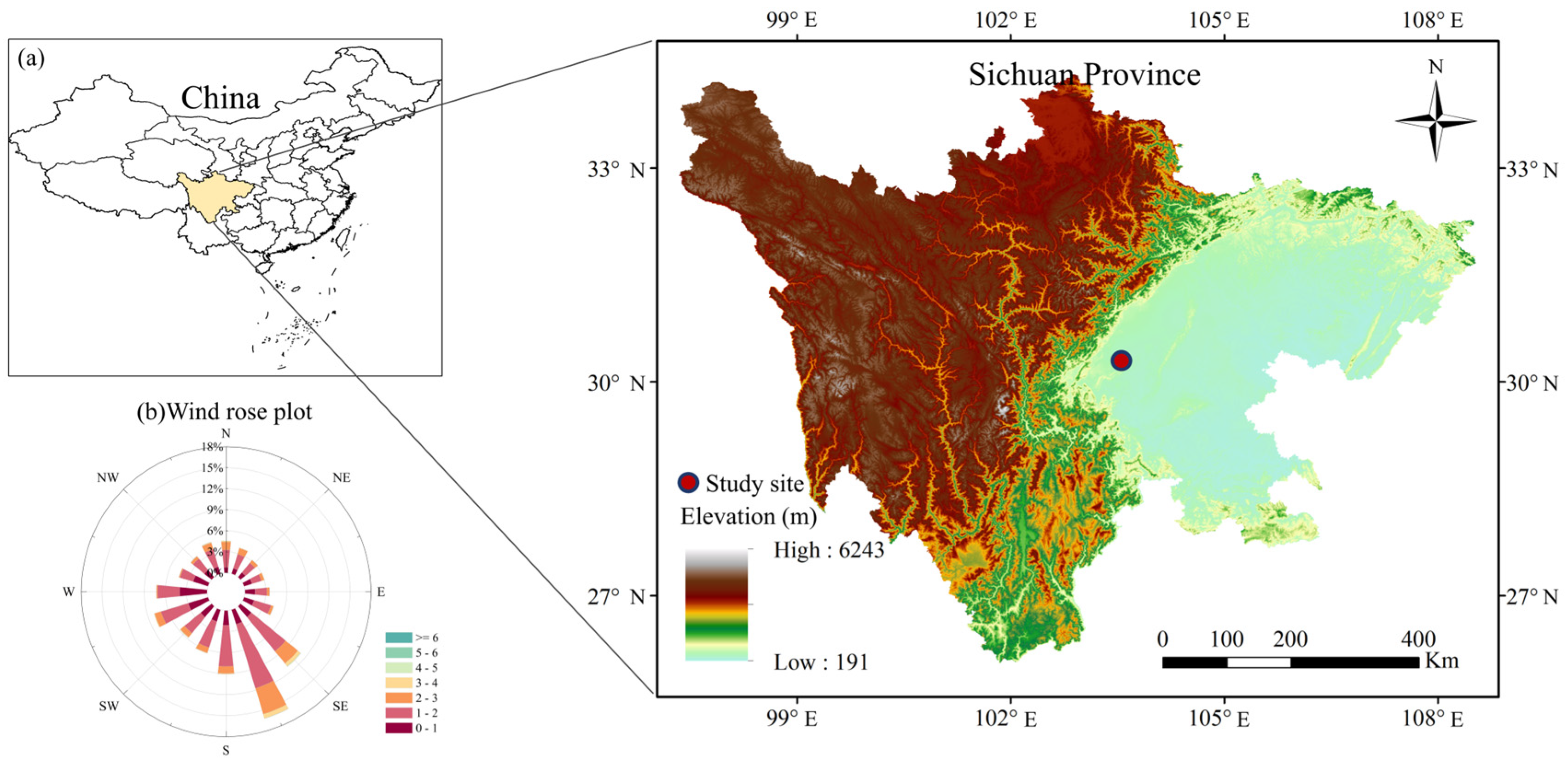
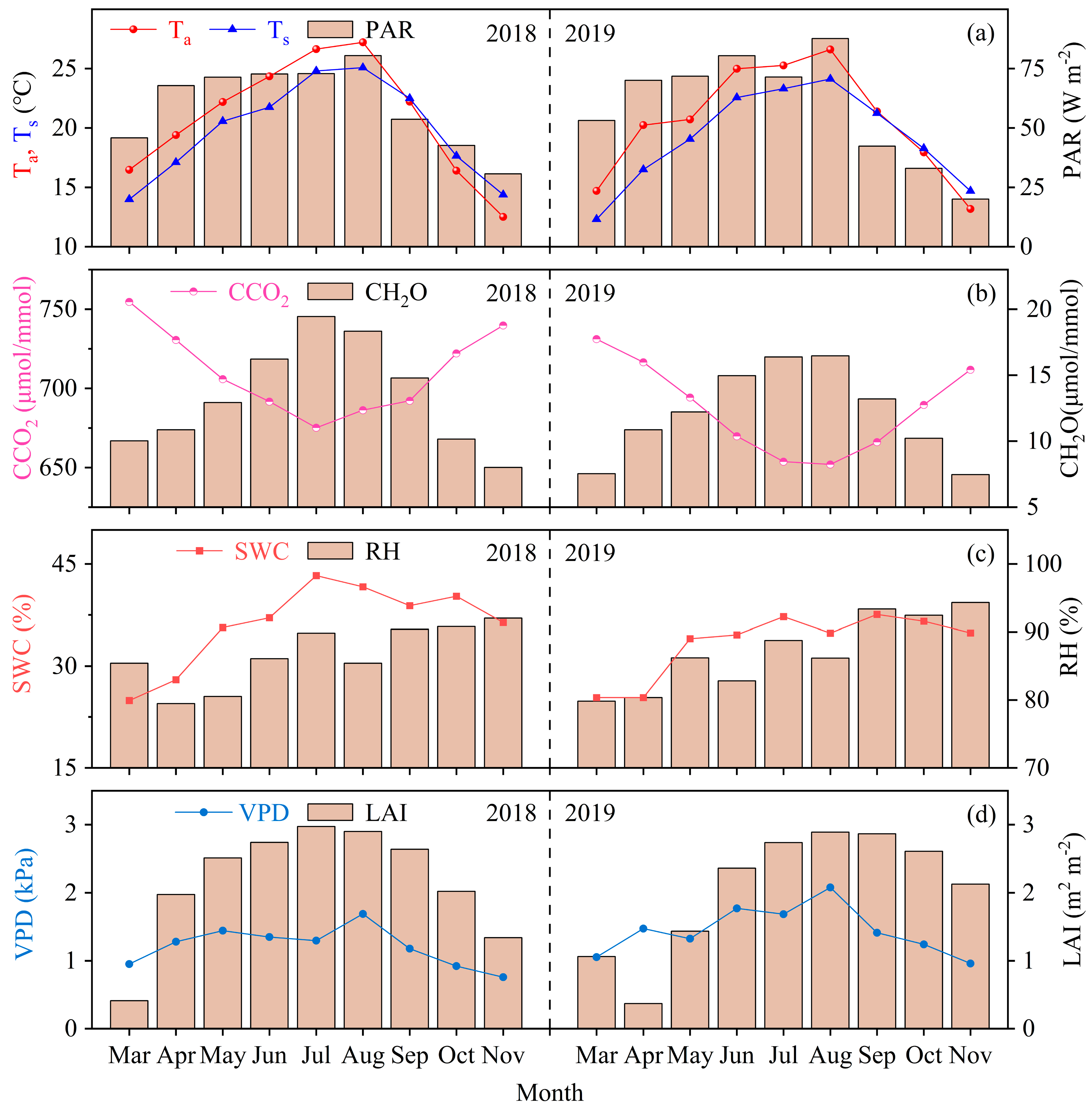
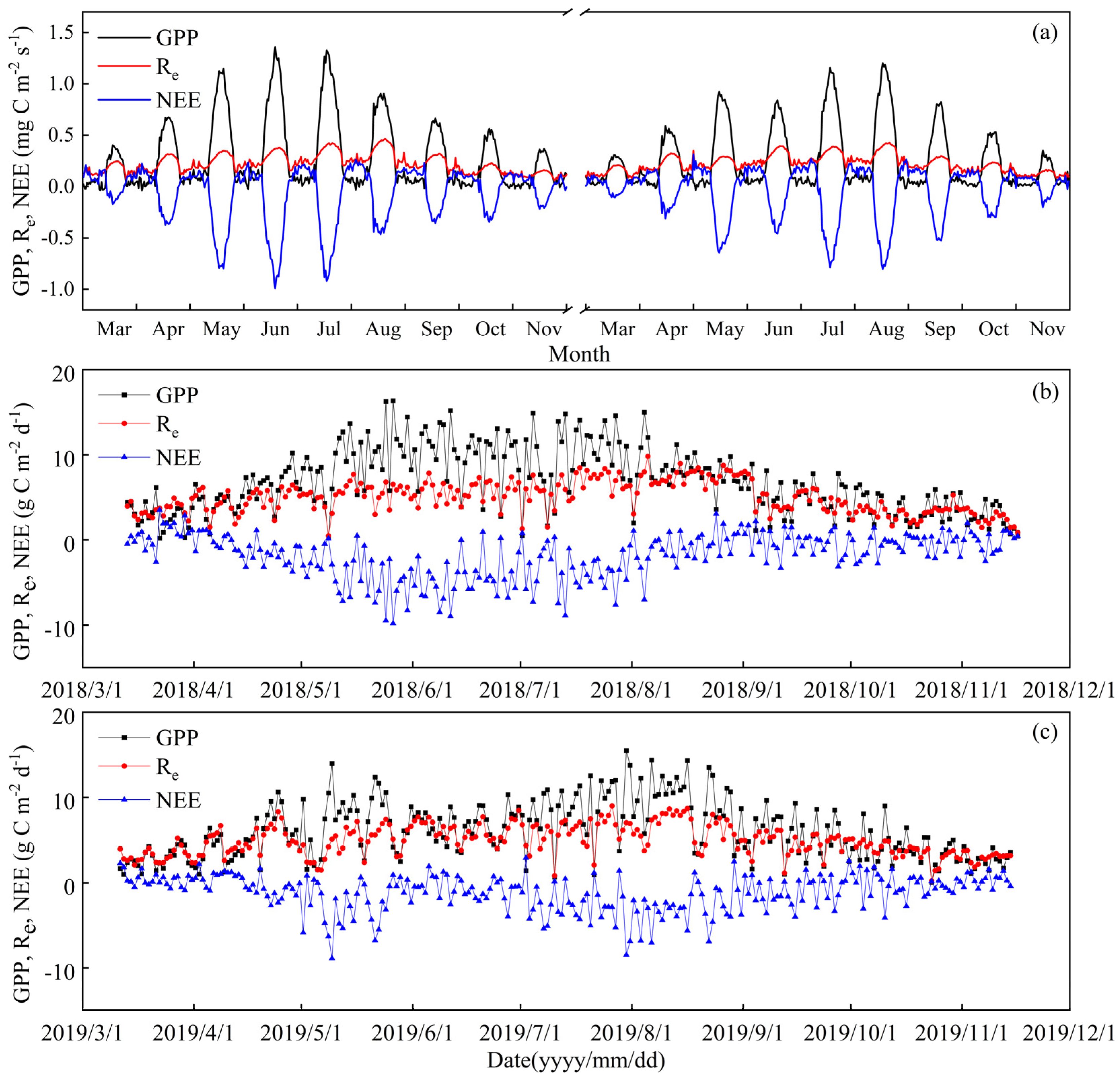
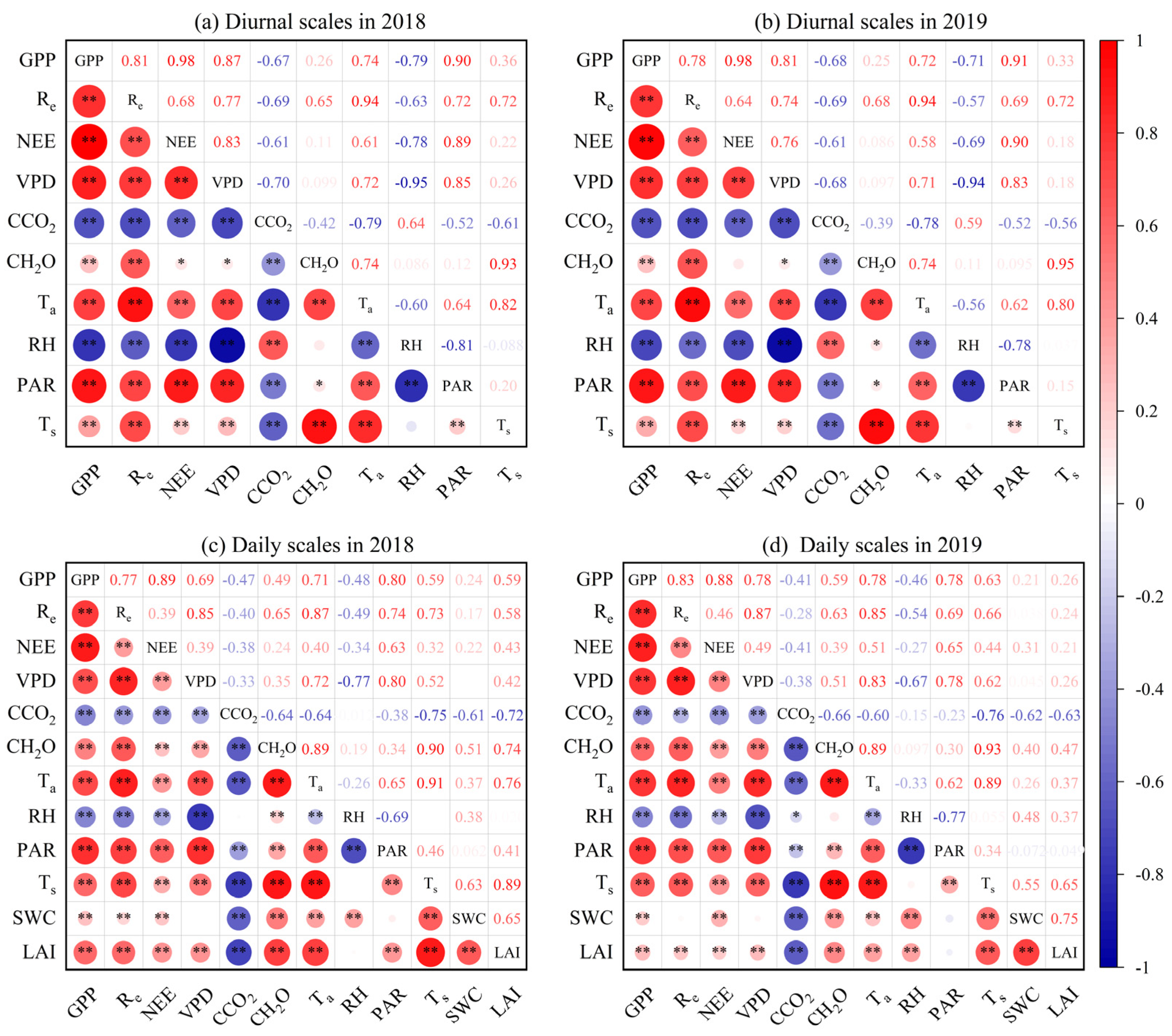


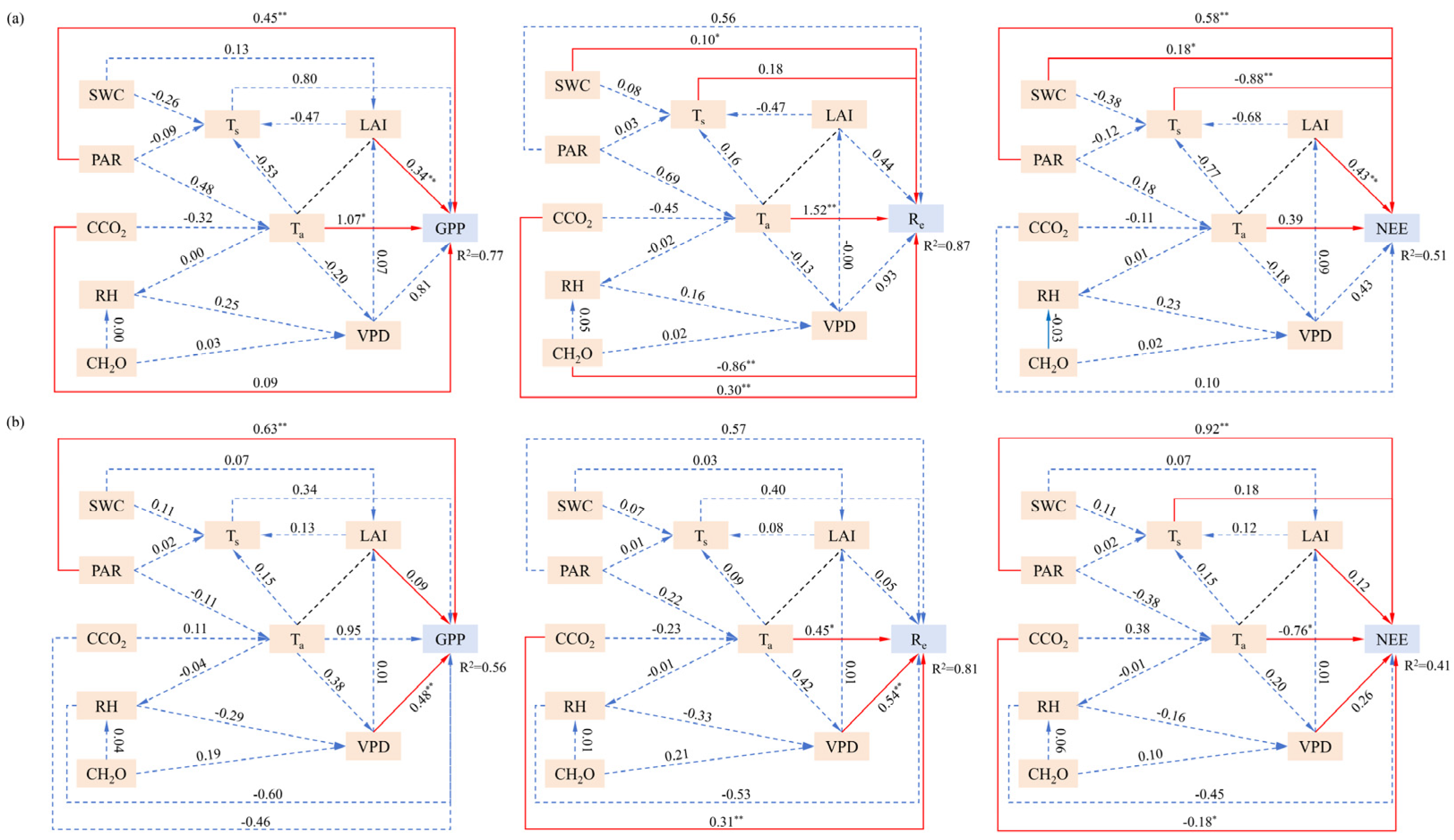
| Variables | Sensor Model | Installation Height (m) | Abbreviation | Unit |
|---|---|---|---|---|
| Air temperature | PTS-3 | 2.5 | Ta | °C |
| Air relative humidity | PTS-3 | 2.5 | RH | % |
| Precipitation | L3 | 0.6 | P | mm |
| Photosynthetically active radiation | ZF-1 | 3.5 | PAR | W·m−2 |
| Soil temperature | PTWD-2A | −0.05, −0.10, −0.15, −0.20 | Ts | °C |
| Soil moisture content | TDR-3 | −0.20, −0.40, −0.60, −0.80 | SWC | % |
| Year | Carbon Fluxes | Month | Mean | Total | ||||||||
|---|---|---|---|---|---|---|---|---|---|---|---|---|
| Mar | Apr | May | Jun | Jul | Aug | Sep | Oct | Nov | ||||
| 2018 | GPP | 2.75 | 5.51 | 9.41 | 10.25 | 9.85 | 8.18 | 5.13 | 3.67 | 2.66 | 6.77 | 1684.66 |
| Re | 3.45 | 4.58 | 5.29 | 5.65 | 6.22 | 7.31 | 4.88 | 3.21 | 2.52 | 4.99 | 1240.41 | |
| NEE | 0.70 | −0.93 | −4.11 | −4.61 | −3.63 | −0.87 | −0.25 | −0.46 | −0.14 | −1.79 | −444.25 | |
| 2019 | GPP | 2.82 | 4.98 | 6.95 | 6.74 | 8.47 | 9.46 | 5.65 | 3.89 | 2.24 | 5.88 | 1526.27 |
| Re | 3.21 | 4.87 | 4.58 | 6.07 | 6.02 | 6.50 | 4.61 | 3.67 | 2.66 | 4.78 | 1242.09 | |
| NEE | 0.39 | −0.11 | −2.4 | −0.67 | −2.48 | −2.96 | −1.04 | −0.22 | 0.42 | −1.10 | −285.77 | |
Disclaimer/Publisher’s Note: The statements, opinions and data contained in all publications are solely those of the individual author(s) and contributor(s) and not of MDPI and/or the editor(s). MDPI and/or the editor(s) disclaim responsibility for any injury to people or property resulting from any ideas, methods, instructions or products referred to in the content. |
© 2025 by the authors. Licensee MDPI, Basel, Switzerland. This article is an open access article distributed under the terms and conditions of the Creative Commons Attribution (CC BY) license (https://creativecommons.org/licenses/by/4.0/).
Share and Cite
Yu, X.; Cui, N.; He, Y.; Wang, M.; Zheng, S.; Zhao, L.; Wei, R.; Jiang, S. Variation and Controlling Factors of Carbon Flux over a Humid Region Kiwifruit Orchard in Southwest China. Sustainability 2025, 17, 258. https://doi.org/10.3390/su17010258
Yu X, Cui N, He Y, Wang M, Zheng S, Zhao L, Wei R, Jiang S. Variation and Controlling Factors of Carbon Flux over a Humid Region Kiwifruit Orchard in Southwest China. Sustainability. 2025; 17(1):258. https://doi.org/10.3390/su17010258
Chicago/Turabian StyleYu, Xiuyun, Ningbo Cui, Yuxin He, Mingjun Wang, Shunsheng Zheng, Lu Zhao, Renjuan Wei, and Shouzheng Jiang. 2025. "Variation and Controlling Factors of Carbon Flux over a Humid Region Kiwifruit Orchard in Southwest China" Sustainability 17, no. 1: 258. https://doi.org/10.3390/su17010258
APA StyleYu, X., Cui, N., He, Y., Wang, M., Zheng, S., Zhao, L., Wei, R., & Jiang, S. (2025). Variation and Controlling Factors of Carbon Flux over a Humid Region Kiwifruit Orchard in Southwest China. Sustainability, 17(1), 258. https://doi.org/10.3390/su17010258








